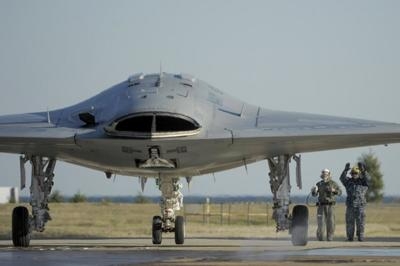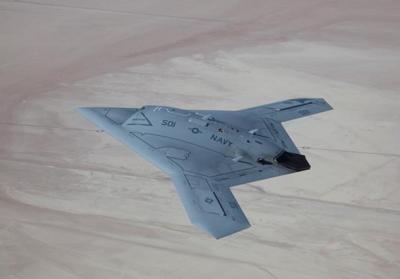Mon, Nov 19, 2012
Maneuvers With Handheld Controller Build Confidence For Future Trials On Carrier Deck
UAV carrier ops took another notch forward recently, as the U.S. Navy took the first critical step toward demonstrating that the X-47B Unmanned Combat Air System (UCAS) demonstrator can be maneuvered safely and wirelessly on the crowded deck of an aircraft carrier.

In early November, the team successfully completed its first shore-based trials of a new wireless, handheld device called a Control Display Unit (CDU). Developed by Northrop Grumman, the device will allow deck operators to maneuver the X-47B by remote control on the carrier deck. The team demonstrated the CDU's ability to control the X-47B's engine thrust; to roll the aircraft forward, brake and stop; to use its nose wheel steering to execute tight, precision turns; and to maneuver the aircraft efficiently into a catapult or out of the landing area following a mock carrier landing. Northrop Grumman is the Navy's prime contractor for the UCAS Carrier Demonstration (UCAS-D) program.
"The CDU is fundamental to integrating the X-47B seamlessly into carrier deck operations," said Daryl Martis, Northrop Grumman's UCAS-D test director. "It will allow us to move the aircraft quickly and precisely into the catapult for launch, or out of the landing area following recovery. Both of these activities are essential to maintaining the rhythm of the flight deck."
In practice, a deck operator will work in tandem with the flight deck director – aka a "yellow shirt" – to move the X-47B via the CDU to a designated flight deck location. Standing in front of the aircraft, the director will use traditional hand signals to indicate how, when and where the aircraft should move, the same way he would communicate with a pilot in a manned aircraft. The deck operator will stand behind the director and use the CDU to duplicate the director's instructions as digital commands to the aircraft. According to Martis, the CDU will help streamline and, in fact, enable many of the flight test operations required for UCAS-D shore-based carrier suitability testing. "Instead of towing the aircraft out to the flight line, we can now start the X-47B outside its hangar, then use the CDU to taxi it out to the runway, or into a catapult for launch," he said. "Use of the CDU is the most time-efficient way to move the X-47B into the catapult or disengage it from the arresting gear
after landing."
The UCAS-D program plans to conduct its first shore-based catapults of X-47B aircraft later this month. That testing will be followed by hoisting an X-47B aboard an aircraft carrier, and using it to validate the performance of the CDU in an actual carrier environment.
(U.S. Navy images)

More News
Also: New Lakeland Fly-in!, Gleim's DPE, MOSAIC! Nearly three-quarters of a century in the making, EAA is excited about the future… especially with the potential of a MOSAIC>[...]
Estimated (EST) -When used in NOTAMs “EST” is a contraction that is used by the issuing authority only when the condition is expected to return to service prior to the >[...]
Aero Linx: Regional Airline Association (RAA) Regional airlines provide critical links connecting communities throughout North America to the national and international air transpo>[...]
The Airplane Broke Up In Flight And Descended To The Ground. The Debris Path Extended For About 1,435 Ft. Analysis: The pilot, who was the owner and builder of the experimental, am>[...]
From 2015 (YouTube version): History Comes Alive Thanks to A Magnificent CAF Effort The story of the Douglas C-47 named, “That’s all Brother,” is fascinating from>[...]
 Airborne 07.21.25: Nighthawk!, Hartzell Expands, Deltahawk 350HP!
Airborne 07.21.25: Nighthawk!, Hartzell Expands, Deltahawk 350HP! ANN's Daily Aero-Term (07.27.25): Estimated (EST)
ANN's Daily Aero-Term (07.27.25): Estimated (EST) ANN's Daily Aero-Linx (07.27.25)
ANN's Daily Aero-Linx (07.27.25) NTSB Final Report: Luce Buttercup
NTSB Final Report: Luce Buttercup Classic Aero-TV: 'That's All Brother'-Restoring a True Piece of Military History
Classic Aero-TV: 'That's All Brother'-Restoring a True Piece of Military History




